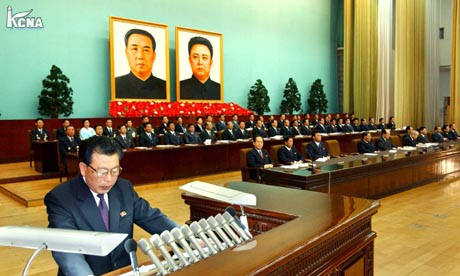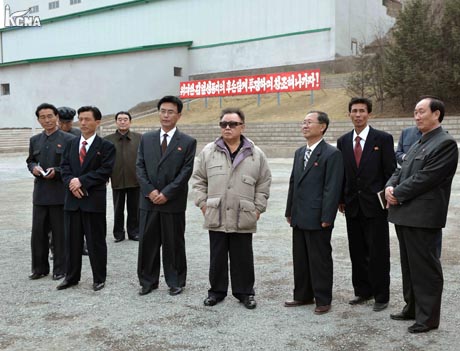If I Were a Cadre and You Were a Lathe Machine Operator
DPRK media reported on 23 April that Kim Cho’ng-il made his first reported visit to the Najin Shipyard. Yonhap reports:
Kim “provided field guidance to the Rajin Shipyard” in the North’s northeastern port of Rajin, accompanied by top military leaders, the official Korean Central News Agency (KCNA) reported.
It was the first time that the North’s tightly controlled media reported the name of the shipyard and Kim’s visit there. Known as one of three major shipyards in North Korea, the Rajin Shipyard is believed to have built warships and submarines, according to sources in Seoul.
During the visit, Kim underlined “the need for the shipyard to continue waging a dynamic struggle to build more cargo ships,” the KCNA said.
“It is of very weighty importance for our country surrounded by seas on its three sides to massively build various types of fishing boats as well as large cargo ships,” Kim said in the report.
This was Kim Cho’ng-il’s 4th public appearance since KIS Birthday on 15 April, for which he made only one report appearance when he attended a concert. On 22 April [Friday] DPRK media reported he visited Hyesan Youth Mine. On 21 April [Thursday] he was reported visiting Suso’ngch’o’n General Foodstuff Factory and Kim Ch’aek Iron and Steel Complex in North Hamgyo’ng Province. Kim Cho’ng-il was last reported visiting the Kim Ch’aek complex on 6 December 2010. KCNA reports:
The construction of the above-said heating furnace made it possible to produce as many billets as they want by using as fuel the gas from the furnace, not using heavy oil at all, he said, highly appreciating the remarkable technological progress being made in all processes as required by the era of knowledge-based economy.
He extended thanks to the officials, workers and technicians of the complex and other domain related to it for making a big contribution to putting the metal industry on a Juche-oriented and modern basis while steadily boosting the production of iron and steel.
The complex plays a very important role in the nation’s economic development, he noted, setting forth important tasks to be carried out by it.
He said that the most important task facing the complex is to expand the scope of the juche iron production, attain the goal of placing production on a CNC basis earlier than scheduled and operate not only the hot-rolling process but the cold-rolling process in the indigenous manner with a view to sufficiently supplying varieties and diverse standards of iron and steel required by various sectors of the national economy.
The relevant enterprises have important roles to play for keeping the production going at a high rate at the complex, he said, adding that it is necessary for power stations, mines and coal mines in charge of the supply of electricity, raw materials and fuel to supply more power, concentrated iron ore and coal to it in time.
Kim Cho’ng-il’s spate of economic-related visits comes with a report in Cambodian media of a construction investment by the DPRK of $17 million [USD]. While he was touring North Hamgyo’ng, a meeting was held to read a new tract, credited to KCI, on machine building. KCNA reports:
The work, published on March 30, juche 100 (2011), deals with validity and vitality of the movement which has developed in depth under the leadership of the WPK. It also clarifies the orientation and ways for updating machines and equipment and production processes as required by the developing reality.
Hyon Sang Ju, chairman of the C.C., the General Federation of Trade Unions of Korea [GFTUK], said in his report that the work is a highly important guideline that the officials and working people should always hold fast to in their efforts to push ahead with CNC, modernization drive based on latest science and technology and increase the might of the Juche-oriented industry.
In spring of 1961 Kim Jong Il showed a shining example in management of equipment at the Pyongyang Textile Machine Factory, the reporter said, adding: In the early 1980s, the WPK took a radical step to develop the model machine movement into the “Lathe No. 26” Model Machine Movement so that the vitality of this movement could be displayed to the full.

Hyo'n Sang-chu, Chairman of the GFTUK's Central Committee, reading a report at "a meeting of forerunners" of the Lathe No. 26 Movement on 20 April 2011 (Photo: KCNA)
Earlier in April, the SPA presented two classes of model machine awards to a number of different sites and production units. The “Lathe No. 26” Model Machine Movement is the final passage in KCI’s official biography before he became a party member:
During his practice at the Pyongyang Textile Machine Factory, he aroused the workers of the factory to launch a movement for model machines in maintenance and operation, personally handing lathe No. 26. This became the inception of the “model machine movement of loyalty for emulating lathe No. 26,” which is now conducted as a mass movement.
